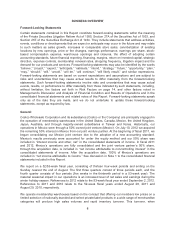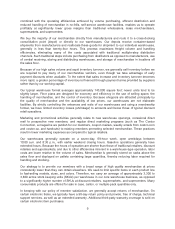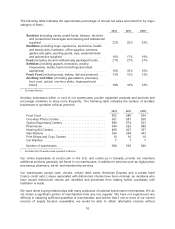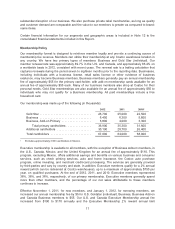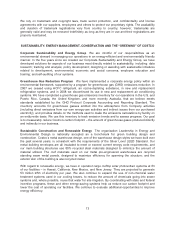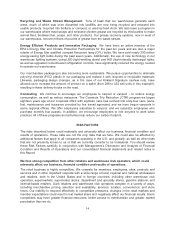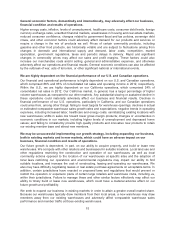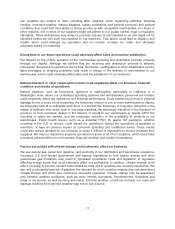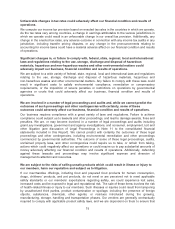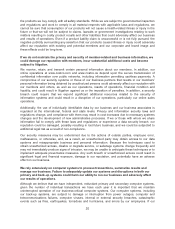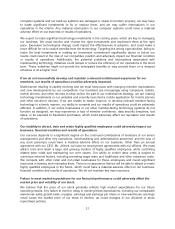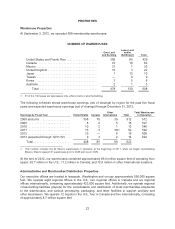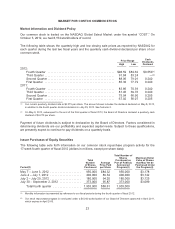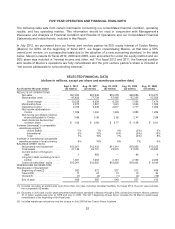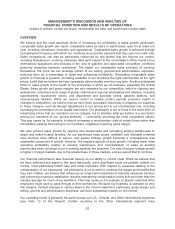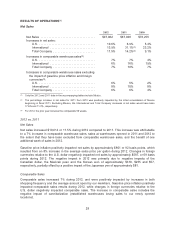Costco 2012 Annual Report Download - page 20
Download and view the complete annual report
Please find page 20 of the 2012 Costco annual report below. You can navigate through the pages in the report by either clicking on the pages listed below, or by using the keyword search tool below to find specific information within the annual report.Our international operations subject us to risks associated with the legislative, judicial,
accounting, regulatory, political and economic factors specific to the countries or regions in
which we operate which could adversely affect our business, financial condition and results of
operations.
During 2012, our international operations, including Canada, generated 28% of our consolidated net
sales. We plan to continue expanding our international operations. As a result of these expansion
activities in countries outside the U.S., we expect that our international operations could account for a
larger portion of our net sales in future years. Future operating results internationally could be
negatively affected by a variety of factors, many similar to those we face in the U.S., but many of which
are beyond our control. These factors include political conditions, economic conditions, regulatory
constraints, currency regulations and exchange rates, and other matters in any of the countries or
regions in which we operate, now or in the future. Other factors that may impact international
operations include foreign trade, monetary and fiscal policies and the laws and regulations of the U.S.
and foreign governments, agencies and similar organizations, and risks associated with having major
facilities located in countries which have been historically less stable than the U.S. Risks inherent in
international operations also include, among others, the costs and difficulties of managing international
operations, adverse tax consequences and greater difficulty in enforcing intellectual property rights.
Additionally, foreign currency exchange rates and fluctuations could have an adverse impact on our
future costs or on future profits and cash flows from our international operations.
Changes in accounting standards and subjective assumptions, estimates and judgments by
management related to complex accounting matters could significantly affect our financial
condition and results of operations.
Generally accepted accounting principles and related accounting pronouncements, implementation
guidelines and interpretations with regard to a wide range of matters that are relevant to our business,
including, but not limited to, revenue recognition, sales returns reserves, impairment of long-lived
assets, inventories, vendor rebates and other vendor consideration, self-insurance liabilities, income
taxes, unclaimed property laws and litigation, and other contingent liabilities are highly complex and
involve many subjective assumptions, estimates and judgments by our management. Changes in
these rules or their interpretation or changes in underlying assumptions, estimates or judgments by our
management could significantly change our reported or expected financial performance.
Provisions for losses related to self-insured risks are generally based upon independent actuarially
determined estimates. The assumptions underlying the ultimate costs of existing claim losses can be
highly unpredictable, which can affect the liability recorded for such claims. For example, variability in
inflation rates of health care costs inherent in these claims can affect the amounts realized. In March
2010, the Patient Protection and Affordable Care Act and the Health Care and Education
Reconciliation Act of 2010 were enacted. This legislation expands health care coverage to many
uninsured individuals and expands coverage to those already insured. We expect our healthcare costs
to increase, though not materially, as a result of this legislation. Similarly, changes in legal trends and
interpretations, as well as a change in the nature and method of how claims are settled can impact
ultimate costs. Although our estimates of liabilities incurred do not anticipate significant changes in
historical trends for these variables, any changes could have a considerable effect upon future claim
costs and currently recorded liabilities and could materially impact our consolidated financial
statements.
18


